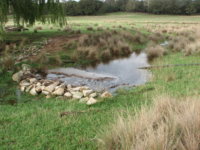- Thread starter
- #11
The Old Ram-Australia
Herd Master
- Joined
- Jan 18, 2011
- Messages
- 990
- Reaction score
- 2,146
- Points
- 303
I assume that is your pasture on the lower 2/3rds of the photo. Why is it brown/dead & dry but green beyond the fence?
Did a wildfire cross on the lower part of the area?
G'day GB,as always you are really observant.The area above the fence is the top of this catchment ,had not been grazed for about 5 months and had had the benifiet of the odd shower.By not grazing the tops the penetration was maximized and the Native sps that actually covers the whole area responded.The lower portion had been spring grazed ,but the dry summer and hot westerly winds had "burnt " the crowns right to the ground, but this sps is amazing it responds summer or winter to rainfall as you can see from the "after" pic,This particular paddock had "not" received one once of super/nitrogen for over 30 years,which adds to the value of the plant ,the protein value of the green plant is over 15%.It spreads by both seed and underground runners.The sps is quite evident in all 3 pics...T.O.R.

